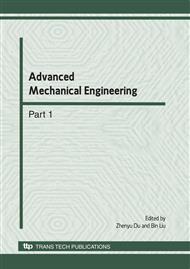p.493
p.498
p.502
p.507
p.512
p.517
p.523
p.528
p.535
Research on Dynamic Behaviors for a Parallel Machine Tool Considering Elastic Component
Abstract:
In order to obtain dynamic behaviors of a spatial rigid-flexible coupling system of PMT(parallel machine tool) without the construction of mathematical model, a new method for dynamic behaviors simulation, which integrates CAD, CAE and visual technologies, was presented. The solid model of PMT was built in SolidWorks and transmitted to ADAMS, the modal neutral file of flexible body including driving limbs and spherical joints were generated in ANSYS, and introduced into ADAMS, then the rigid-flexible coupling model of PMT was build. Based on the rigid-flexible coupling model, the dynamic behaviors, which includes displacements error output response, dynamic stress of driving limbs and natural frequency, were realized. The simulation results show that the rigid-flexible coupling model established can indicate the dynamic behaviors of PMT. The flexibility of driving limbs and spherical joints are demonstrated to have significant impact on dynamics characteristics of PMT. This research can provide the important theoretical base of the optimization design of dynamic parameters for PMT.
Info:
Periodical:
Pages:
512-516
Citation:
Online since:
June 2010
Authors:
Price:
Сopyright:
© 2010 Trans Tech Publications Ltd. All Rights Reserved
Share:
Citation:


